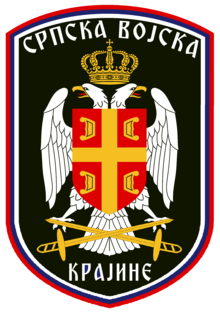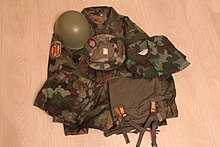Serbian Army of Krajina
You can help expand this article with text translated from the corresponding article in Serbian. (August 2012) Click [show] for important translation instructions.
|
| Serbian Army of Krajina | |
|---|---|
| Српска Војска Крајине Srpska Vojska Krajine | |
 Officer emblem of SVK, 1993–1995 | |
| Foundation | October 17, 1992 (30 years ago) |
| Dates of operation | 1992–1995 |
| Dissolved | August 7, 1995 (27 years ago) |
| Allegiance | |
| Headquarters | Knin |
| Size | 30,000[1] |
| Battles and wars | Operation Stinger, Operation Medak Pocket, Operation Maslenica, Operation Summer '95, Operation Whirlwind, Operation Flash, Operation Storm |
| Colors | (Serbian tricolour) |
| War flag |  |
The Serbian Army of Krajina (SAK, Serbo-Croatian: Srpska vojska Krajine, Српска војска Крајине, abbr. SVK), also known as the Army of the Republic of Serbian Krajina or Krajina Serbian Army, was the armed forces of the Republic of Serbian Krajina (RSK). The SVK consisted of ground and air elements.
Created through the merger of the Territorial Defense of the Republic of Serbian Krajina (TORSK), units of the Yugoslav People's Army (JNA) and the Krajina Militia, the SVK was officially established on 19 March 1992. Responsible for the security of the RSK, its area of responsibility covered an area of some 17,028 km² at its peak, as it was located entirely inland it thus had no naval forces. The SVK, along with the state of RSK, ceased to exist in 1995 following the Croatian military offensive Operation Storm.
Organization
Commanders-in-Chief
| No. | Portrait | Commander-in-Chief | Took office | Left office | Time in office | Party | |
|---|---|---|---|---|---|---|---|
| 1 | Milan Babić (1956–2006) | 19 December 1991 | 16 February 1992 | 1 month | SDS | ||
| 2 | Goran Hadžić (1958–2016) | 26 February 1992 | 12 December 1993 | 1 year, 9 months | SDS | ||
| (1) | Milan Babić (1956–2006) | 12 December 1993 | 23 January 1994 | 1 month | SDS | ||
| 3 | Milan Martić (born 1954) | 23 January 1994 | 7 August 1995 | 1 year, 6 months | SPS | ||
Commanders
| No. | Portrait | Commander | Took office | Left office | Time in office | Defence branch |
|---|---|---|---|---|---|---|
| 1 | Major general Mile Novaković (1950–2015) | 1992 | 1994 | 1–2 years | ||
| 2 | Major general Milan Čeleketić (born 1946) | 1994 | 1995 | 0–1 years | ||
| 3 | General Mile Mrkšić (1947–2015) | 1995 | 1995 | 0 years |
Structure



- 105th Aviation Brigade
- 44th Air defense rocket brigade
- 75th Mixed artillery brigade
- "Pauk" Operational Group
- Special forces corps
- 7th Dalmatia (Dalmatinski) corps
- 15th Lika (Lički) corps
- 21st Kordun (Bordunski) corps
- 39th Banija (Banijski) corps
- 18th West-Slavonia (Zapadnoslavonski) corps
- 11th East-Slavonia (Istočnoslavonski) corps
At the creation of the army, it was planned that its number would be 80,000 people, however it turned out to be less.
- According to Colonel Kosta Novaković: 62,483 (772 officers, 2,709 non-commissioned officers and 59,002 soldiers) or 78% of the planned number.[2]
- According to the General Staff in 1994: 62,805 (2,890 officers, 4,329 non-commissioned officers and 55,886 soldiers).[3]
- According to General Milisav Sekulić: 71,409 (3,291 officers, 3,424 non-commissioned officers and 60,496 soldiers).[3]
Equipment
- Armored Vehicles
- Artillery
- Anti-aircraft
- Aircraft
- Other
Gallery
-
Krajina Airforce G-2 Galeb
-
Krajina Airforce Aérospatiale Gazelle
-
Krajina Airforce Utva 66
-
Krajina Airforce Zlin Z-526
War crimes
During the Croatian War of Independence, numerous massacres were conducted by the Army of Serbian Krajina. On 2–3 May 1995, seven civilians were killed and many more injured in the Zagreb rocket attacks.[4][5]
The main leaders of the Serbian Army of Krajina, Milan Martić, Milan Babić and Goran Hadžić, were indicted and trialled by the ICTY for various war crimes and crimes against humanity. Milan Martić was sentenced to 35 years in prison,[6] Milan Babić was sentenced to 13 years,[7] while Goran Hadžić died shortly after their trial started.[8]
See also
References
- ^ Dixon, Jeffrey S.; Sarkees, Meredith Reid (2015). A Guide to Intra-state Wars: An Examination of Civil, Regional, and Intercommunal Wars, 1816–2014. Washington, D.C.: CQ Press. p. 313. ISBN 978-1-50630-081-8.
- ^ Novaković 2009, p. 292.
- ^ a b "Фактори односа снага у српско-хрватском сукобу: [(рат за опстанак Срба крајишника)]: зборник радова [учесника научног скупа одржаног 28-29. новембра 2009. године у Бањи Јунаковић, Апатин]. 2". plus.cobiss.net. University Library 'S. Marković', Belgrade: 295 стр. 2011. ISBN 978-86-83809-68-4.
- ^ "Prosecutors Seek Life Sentence for War Crimes Suspect Martic". Voice of America. 10 January 2007. Retrieved 12 June 2007.
- ^ "War crimes suspects surrender to tribunal". BBC News. 15 May 2002. Archived from the original on 16 September 2008. Retrieved 2 January 2011.
- ^ "Serb leader jailed for war crimes". BBC News. 12 June 2007. Retrieved 12 June 2007.
- ^ "Judgement in the Case the Prosecutor v. Milan Babic". Archived from the original on 17 July 2007. Retrieved 3 July 2006.
- ^ "Goran Hadžić dead". Retrieved 12 July 2016.
Sources
- Vrcelj, Marko (2002). Rat za Srpsku Krajinu: 1991-1995. Zora. ISBN 9788683809066.
- Novaković, Kosta (2009). Srpska krajina: usponi, padovi, uzdizanja. Zora. ISBN 978-86-83809-54-7.
- "The Army of Serbian Krajina", Jane's Intelligence Review, 1 October 1993
External links
- "Vojska Republike Srpske Krajine". Archived from the original on 30 December 2008.










